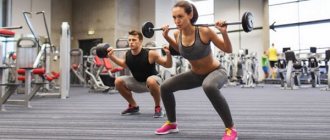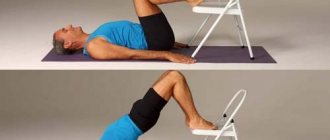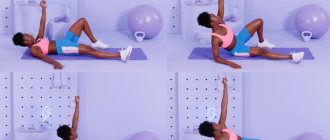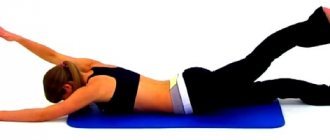© Drobot Dean - stock.adobe.com
Share:
What you need
- Barbell
- Dumbbells
- Horizontal bar
- Exercise equipment
When considering CrossFit and other areas of modern fitness, one cannot help but touch on the topic of circuit training, which is basic for many sports. What is it and how does it help beginners and professional athletes? Let's look further.
General information
Circuit training has been widely used almost from the very beginning of non-core sports disciplines. However, it received systematic justification with the development of weightlifting areas of fitness.
In particular, Joe Weider is considered one of the key figures in the development of circuit training, who created his split system as a contrast to unsystematized training. However, through opposition, he also created a basic theoretical system for substantiating circuit training, the principles on which it is based today.
Circular training for all muscle groups, according to Weider's definition, is a high-intensity training method that should involve all muscle groups and become maximum stress for the athlete's body, which will stimulate his body to further transformations.
Principles
Circular training for all muscle groups implies compliance with certain principles that distinguish it from other types of training:
- Maximum stress load. Maximum stress – stimulates the body to more intensive recovery, which allows you to achieve certain results much faster. However, at the initial stage, you should not perform every exercise to failure.
- High intensity training. Allows you to develop not only muscle strength, but also related energy systems (for example, the functioning of the cardiovascular system). There is no break between exercises in the circle or minimal – 20-30 seconds. Rest 1.5-2 minutes between circles. Number of circles – 2-6.
- Short duration. The short training time makes it accessible to most athletes. As a rule, such an activity takes 30-60 minutes (depending on the number of laps).
- Availability of strict specialization. The principles of developing circular training only imply a load on all muscle groups. The type of load determines the specialization factor of the main sport.
- Work your entire body in one workout. Typically, one exercise is allocated for each muscle group. At the same time, the order in which they are worked out changes from training to training. For example, on the first day you start with an exercise on the chest, on the second day - on the back, and so on.
- The intensity of the load on different muscle groups is determined by their size and susceptibility to loads. Basic exercises should be used primarily.
In bodybuilding and fitness, circuit training is used by beginners who find it difficult to immediately perform heavy multi-joint exercises with free weights, and during the drying phase. Gaining mass based solely on circuit training will not be effective. At this stage, the use of such a system is advisable only within the framework of load periodization.
What is circuit training
Metabolic training is an intense combination of traditional strength training and high-repetition programs that will give you a serious cardio workout and is great for burning fat for men and women.
Any variants of circuit training for burning involve performing exercises one after another with short pauses for rest between them, resulting in an excellent load on the whole body, from which body fat begins to actively melt, while simultaneously improving the endurance of the heart and blood vessels and working out every muscle of the body in process.
Circuit training is a method of performing one set of exercises one after another at high intensity in order to increase endurance or to enhance fat burning while cutting.
Circuit training for fat burning can consist of both strength and aerobic cardio exercises. The entire workout is divided into a certain number of exercise circles, ranging from 1 to 6, with minimal rest between them, about 30 seconds or no break at all.
Rest between circles ranges from 2 to 5 minutes, depending on personal capabilities.
The lesson can be completed after one lap, or you can complete as many laps as your endurance allows. In one workout, all the main muscle groups of the body are worked out, one lesson can include from 2 to 6 circles, the total duration of classes is from 30 to 60 minutes.
This method of training is suitable for both beginner athletes and experienced athletes during drying or in the process of developing endurance. They can be of a wave nature (weak, medium and high). The intensity increases as the number of circuits, repetitions, and rest periods become shorter.
All exercises are done with 12 repetitions or more. If this amount is easy for you, then you need to increase the working weight or the number of repetitions.
To obtain a fat-burning effect, it is necessary to maintain a calorie deficit in the diet, but you should not go on a very strict diet - this will inevitably lead to a breakdown during regular training in the gym.
Peculiarities
- Complexes can consist of both basic multi-joint exercises and isolating single-joint movements.
- You can exercise in machines or with free weights, but you need to select weights that allow you to follow a safe technique. Because drying is more likely to cause injury.
- The entire workout should be done in a multi-rep pump mode in the range of 15 repetitions and above. This stimulates the development of the capillary network to improve the delivery of nutrients to the muscles.
- You need to exercise 3 times a week or more, some do 2 times a day, for example, cardio in the morning and strength training with weights in the evening.
When is it more effective to use
- For beginners who have just started working out in the gym with weights, to create a base, preparing ligaments and joints for heavy loads;
- To develop endurance;
- Increasing functional performance when playing other sports in order to increase explosive strength and speed;
- Effective when there is a lack of equipment or time for training;
- For intensive fat burning while cutting.
Advantages
- Circuit training allows you to lose weight by burning excess subcutaneous fat, strengthen muscles and improve body contour in a short time.
- Development and strengthening of the cardiovascular system,
- The ability to pump up with little or no equipment, using only body weight.
- The ability to train effectively at home, on vacation, a business trip or lack of free time.
- Accelerating metabolism and improving metabolic processes in the body, not only for weight loss, but also for everyday life.
Minuses
- Not suitable for building muscle mass; it gives results only if there is a certain amount of muscle under the fat layer.
- There is a high probability of burning muscle along with fat, with a severe lack of calories or prolonged exercise for more than 30 minutes.
- It is almost impossible to pay attention to the lagging muscle group.
- When working out at the gym, it's critical to have a lot of free equipment on hand so you can do the exercises one after another. Therefore, it is better to choose a time when the hall is as free as possible.
- Exercising too often and for too long can cause a feeling of chronic fatigue with insufficient nutrition and recovery.
Contraindications
Exercising in a circular style is contraindicated for people who have heart problems, high blood pressure, injuries or recovery from illnesses.
Varieties
Like CrossFit, circuit training is only a method of building training that does not determine the further profiling of the athlete. The foundation laid in the basic principles of such training allows you to create variability in accordance with the needs of the athlete: starting from classical training, which is used in all areas associated with weightlifting (bodybuilding, powerlifting, etc.), and ending with combined athletics training with emphasis for the development of functional capabilities (Tabata, crossfit, etc.).
Let's take a closer look at the main options for circuit training in the table:
| Type of training | Peculiarity | Method of implementation |
| Basic circular | Maximum development of strength indicators by eliminating non-core exercises. | Only basic multi-joint exercises are used. |
| Bodybuilding circular | Maximum harmonious development of the body. Use by beginners as a foundation preparation for the transition to split and by more experienced athletes for drying. | Unlike the basic circular exercise, isolation exercises can be added if necessary. Cardio may be added during the drying phase. |
| Circular in Crossfit | Maximum development of functional strength due to the specifics of performing exercises. | Combining the principles of weightlifting and athletics involves developing functional strength and endurance. |
| Athletics | Maximum development of speed indicators. | Training involves the basic development of all muscle groups with the creation of adjustments for specialization. |
| Tabata Protocol | Maximum intensity combined with minimal training time. | The principle of continuity of training and the creation of suitable intensity is observed through the formation of strict time control in conjunction with monitoring the pulse. |
You need to understand that these types are presented solely as an example, since absolutely any type of training can be built on the principles of basic circuit training. For example, workout or boxer training, each of which has a combined nature and allows you to combine the principles of Tabata and athletics, or powerlifting and CrossFit.
What problems does the training solve?
Circuit training is a method of constructing a lesson that does not determine the athlete’s profile. The main rule in choosing exercises for cyclic training is to involve as many muscle groups as possible. The complexity of the training depends on choosing the right equipment. Cyclic training can be done with free weights, on machines or with your own weight. So, at the Unifecht club, our trainers can choose the types of circuit training that are right for you - Crossfit, Tabata or Functional. The main goal of these classes is to develop endurance and burn fat without losing muscle mass.
Losing excess weight and strengthening muscles
Effective circuit training can burn 30% more fat than regular gym training. This happens thanks to the intensity, which you can adjust to your needs. With circuit training, you can work out all the major muscle groups in a fairly short period. Of course, to achieve maximum results, you should work with a trainer. The Unifecht fitness center has a team of professionals, so with us you will achieve your goals in the shortest possible time.
Relief
The main feature of any circuit training is the fast and effective burning of fat without losing muscle mass. That is why this is an ideal training for “drying” and increasing the definition of your muscles. But it is important to understand that by doing circuit training, you will not be able to increase muscle or gain mass, because this requires heavy strength exercises, few repetitions and long breaks - that is, the exact opposite of this workout.
Burning calories
Circuit training was created with the goal of getting rid of extra pounds. This happens due to the restructuring of metabolism. In addition, during circuit training, growth hormone is produced, which is responsible for burning muscles and increasing the definition of your body with minimal muscle atrophy. In half an hour of such training in a circular mode, a person weighing 55-58 kg burns about 300 kcal, which is equivalent to the load while playing football, hockey, volleyball, or while rock climbing or swimming.
Circuit training and cardio
If strength circuit training alone is boring for you, you can add cardio. A proper combination of cardio and circuit training will help you not only lose weight, but get rid of excess fat, improve your physical performance and increase endurance. You can alternate cardio and strength sessions, or do exercises with elements of both cardio and strength at the same time.
Specialization in the long term
Considering the exercises for circuit training and the principle of its construction, it can be noted that it is never used throughout the year by athletes. It makes sense for beginners to practice this system for 2-4 months. Experienced cutting athletes can use circuit training for 2-3 months. At the recruiting stage, it would be rational to do one week of circuit training every 4-6 weeks as part of the periodization of loads.
Using circuit training all the time is ineffective, since the body gets used to this type of load, which reduces the effectiveness of the training.
Always running program
For those who are looking for an ideal working program, we offer an example of circuit training that is suitable for experienced athletes and beginners with at least minimal experience working with iron:
| Monday | ||
| Bench press on an incline bench | 1x10-15 |
|
| One-arm dumbbell row | 1x10-15 | |
| Leg press in the simulator | 1x10-15 | |
| Lying leg curls in the simulator | 1x10-15 |
|
| Seated dumbbell press | 1x10-15 |
|
| Standing barbell curls | 1x10-15 |
|
| French bench press | 1x10-15 | |
| Wednesday | ||
| Wide grip pull-ups | 1x10-15 | |
| Dumbbell Bench Press | 1x10-15 | |
| Leg extensions in the simulator | 1x10-15 |
|
| Romanian barbell deadlift | 1x10-15 | |
| Wide grip barbell row | 1x10-15 |
|
| Dumbbell curls while sitting on an incline bench | 1x10-15 |
|
| Triceps extensions on the block | 1x10-15 |
|
| Friday | ||
| Squats with a barbell on your shoulders | 1x10-15 |
|
| Romanian deadlift with dumbbells | 1x10-15 | |
| Dips | 1x10-15 | |
| Bent-over barbell row | 1x10-15 |
|
| Close grip press | 1x10-15 | |
| Scott Bench Curls | 1x10-15 |
|
| Arnold Seated Press | 1x10-15 | |
In total, you need to perform 3-6 such circles, the first of which is a warm-up. Rest between exercises – 20-30 seconds, between circles – 2-3 minutes. In the future, you can increase the intensity of the workout by increasing the number of circles, working weights and reducing rest time. In total, the program involves its implementation for 2-3 months, after which it is better to switch to a classic split.
Note: the division by day of the week remains conditional and implies adjustment to your own training schedule. There is no need to exercise according to this scheme more than 3 times a week.
The main advantages of this approach to training include:
- Lack of specialization for certain muscle groups. This allows you to prepare the athlete’s body for loads in any specialization in the future.
- Versatility. The weight on the equipment is determined by the athlete’s preparedness.
- Short training time. Unlike other sports, canonical circuit training can be done in 30-60 minutes.
- The ability to create adjustments and replace exercises with analogues in accordance with individual preferences.
Circuit training for problem areas
So, our workout will consist of three repeating circles. That is, in each circle you will find 10 exercises, these exercises are repeated in 3 circles. Exercises are performed according to the scheme 30 seconds of work / 10 seconds of rest. Rest 1-2 minutes between circles.
The workout is very moderate in intensity, without intense cardio or impact exercises. However, some of the exercises may seem unfamiliar to you if you have little fitness experience. Therefore, before starting your workout, try to perform a couple of repetitions so as not to waste time learning the exercise technique during the lesson.
The circuit training includes the following exercises:
- Pulse Squat Reversal: 30 pulse movements (30 seconds)
- Plank walk: 7 reps (30 seconds)
- Half squat back lunges: 12 reps on each side (30 seconds)
- Forearm bicycle: 20 reps each side (30 seconds)
- Walking plank on all fours: 7 reps on each side (30 seconds)
- Glute bridge: 20 reps (30 seconds)
- Side lunge with knee tuck: 10 reps on each side (30 seconds)
- Swallow with arms raised to the sides: 8 repetitions on each side (30 seconds)
- Reverse plank with knee tuck: 10 reps on each side (30 seconds)
- Floor scissors: 15 reps each side (30 seconds)
1. Pulse Squat with a Turnaround
Why: This is a very effective, although not simple, exercise for the buttocks, inner thighs, biceps and quadriceps. You'll also be engaging your abdominal muscles, just as you always do with squats.
How to do it: Get into a squat position. The stomach is tucked up, the thighs are parallel to the floor, the feet are straight, the knees look forward and do not go ahead of the toes. Straighten your back, body slightly tilted forward, hands clasped together. Begin performing a pulsating version of the squat by rotating your knees wide out to the side on one pulsation and bringing them back straight on the other pulsation. Do not straighten up throughout the entire exercise, the pelvis is low, the hips and buttocks are in constant tension. Perform the exercise with amplitude, placing your knees wide to the sides.
Lighter version: You can do 10 pulsations and straighten up for a second to relieve muscle tension. Then continue the exercise. Gradually try to perform all the presented circuit training exercises without resting for 30 seconds.
How long to do: 30 pulsating movements or 30 seconds.
2. Walking in the plank
Why: Walking in the plank is an excellent exercise that involves all the muscles of your body and allows you to get rid of problem areas on the arms, stomach, legs and buttocks. Feel free to include plank walking in any circuit workout, no matter what area of the body you want to work on.
How to do it: Stand straight, arms along your body, legs slightly apart. Lower your body down and place your palms on the floor, trying not to round your back. Start moving your arms forward, moving step by step into a plank position. Hold the plank position for a second and return to the starting position. Try to perform this exercise at a dynamic pace - this will quickly increase your heart rate and burn more calories.
Easy Option: Slow down the pace or reduce the number of repetitions to 4-5 if you want to simplify this exercise from circuit training.
How long to do: 7 repetitions or 30 seconds.
3. Back lunges in a half squat
Why: This is a simple but very effective exercise for our circuit training. It will help work the entire lower body and stomach, but especially the muscles of the buttocks, quadriceps and hamstrings.
How to do it: Take a half-squat position: your pelvis is pulled back, your hips are slightly above parallel with the floor. Bend your elbows and place them in front of you approximately parallel to the floor. Maintaining a half-squat position, begin to alternately take a wide step back, leaning on your toes. Shift your weight to your back leg, lowering yourself further into the squat as you move your legs back. Do not straighten your legs; maintain a semi-squat position throughout the entire exercise.
Easier Option: Sit up a little higher in the half squat if you want to make this circuit training exercise easier.
How long to do: 24 reps (12 reps on each side) or 30 seconds.
4. Bicycle on your forearms
Why: This exercise perfectly works the abdominal muscles, especially the lower part. Unlike supine leg raises, which also work the lower abs well, the elbow bike is easier from a technical standpoint, so you'll be less likely to put harmful stress on your lower back. In addition, during this exercise you will feel the work of your leg muscles.
How to do it: Sit on the mat, lower your torso a little back so that you can rest on your forearms. Raise your legs off the floor and begin to alternately pull your knees towards your stomach. Do not raise your legs high above the floor: the lower your legs, the more stress your abdominal muscles receive. Keep your stomach tucked throughout the exercise. Don't slouch your back or pull your shoulders toward your ears.
Easy Option: Raise your legs higher if you want to make this circuit training abdominal exercise easier.
How long to do: 40 reps (20 reps on each side) or 30 seconds.
5. Walking in a plank on all fours
Why: And another great functional exercise that makes all the muscles of your body work intensively - especially the muscles of the abdomen, shoulders, back, buttocks and legs.
How to do it: Get into a plank position on all fours. To do this, get on all fours and raise your knees a few centimeters above the floor. The back remains straight, rest on your palms and toes. From the plank position on all fours, first take your right leg back, then your left, taking the position of a plank on your hands. Then return to a plank position on all fours, stepping forward first with your right foot and then with your left. Perform the next repetition on the other leg. Those. First you perform one repetition on the right side, then one repetition on the left side.
If you are confused in the sequence, then in the first circle, perform this exercise on the right side (that is, the first step is always taken by the right leg), in the second circle on the left side (that is, the first step is always taken by the left leg), in the third circle, 15 seconds for right side, 15 seconds on the left side.
Lighter version: For the easier version, stay in a static plank position on all fours.
How long to do: 14 reps on each side (7 reps on each side) or 30 seconds.
6. Gluteal Bridge
Why: The bridge is an effective and safe exercise for the buttocks, abdominal muscles and hamstrings. It's simple enough that you'll be able to catch your breath a little while doing it in this circuit workout.
How to do it: Lie on your back, bend your knees, and extend your arms along your body. The feet rest on the heels - this will help to better work the gluteal muscles. As you exhale, lift your pelvis as high as possible until your knees, hips, stomach and chest form a straight line. Place your weight on your heels, squeeze your buttocks tightly, and keep your abs tight so as not to put stress on your back during the exercise. Hold the bridge position for a second before returning to the starting position.
Lighter version: The exercise is not difficult, but you can simplify it if you lower your feet completely to the floor.
How long to do: 20 repetitions or 30 seconds.
7. Side Lunge with Knee Pull
Why: The side lunge is an excellent exercise for the buttocks, inner and outer thighs. Do this exercise if you want to have slender and toned legs. Let's complicate this exercise a little by adding knee raises. This will help to further engage your abdominal muscles.
How to do it: Stand up straight with your arms clasped together near your chest. Step your right foot to the side as wide as possible. Shift your weight to your right leg and bend it at the knee until the thigh is parallel to the floor, the knee does not go forward of the toe (to do this, move the pelvis back). The left leg is fully straightened. Hold the side lunge for a split second. Push your right foot off the floor and, being careful not to touch the floor with your foot, pull your right knee towards your left elbow. Return to the starting position and repeat the same on the other left leg.
If you have little space in the room, then in the first circle do this exercise on the right side, in the second circle on the left side, in the third circle 15 seconds on the right side, 15 seconds on the left side.
Lighter version: When returning from a side lunge to the starting position, touch the floor with your foot - this will make it easier for you to maintain balance before lifting your knee. An even easier option is to do side lunges to the side without raising your knees.
How long to do: 20 reps (10 reps on each side) or 30 seconds.
8. Swallow with arms extended to the sides
Why: This exercise will help tighten the muscles of the whole body (arms, stomach, legs), but it is especially effective for the muscles of the buttocks and back of the thigh. In addition, the swallow exercise helps work the deep stabilizing muscles of the core through a complex balancing position.
How to do it: Stand straight with your feet slightly wider than shoulder-width apart. As you exhale, lift your straight leg up, at the same time tilt your body and spread your arms to the sides. Your body and extended leg should be parallel to the floor. The supporting leg is slightly bent at the knee, the raised leg is fully straightened. Tighten your buttocks, keep your stomach tucked. Perform the exercise alternately on one and the other leg. Try to do the exercise thoughtfully and concentrated: not just swinging your legs, but tensing the muscles of the buttocks and back of the thigh.
Light version: For the light version, keep your arms at your side and raise your leg to a moderate height. You can also hold onto a chair.
How long to do: 16 reps (8 reps on each side) or 30 seconds.
9. Reverse plank with knee lift
Why: The reverse plank is one of the best no-equipment exercises for the upper body, especially the back, arms and deep abdominal muscles. In our circuit training, we will complicate this exercise a little by adding leg raises to it for more intensive work of the lower body and abs.
How to do it: Get into a reverse plank position. To do this, sit on the floor, legs extended in front of you, palms resting on the floor slightly behind your back. Push your hands off the floor and lift your pelvis up, tensing your abdominal and buttock muscles. Open your chest, your body forms a straight line from head to feet. From the reverse plank position, alternately pull your right and left knee toward your stomach. The body does not sag and remains elongated in one line throughout the entire exercise. If possible, perform this exercise in front of a mirror to ensure proper body position.
Easy Option: Stay in a static reverse plank if you want to make this circuit training exercise easier.
How long to do: 20 reps (10 reps on each side) or 30 seconds.
10. Scissors
Why: This is an excellent exercise for the abdomen, especially the lower part. Also, when performing scissors, the adductor muscles of the thighs work, which means you will work the area of the inner thigh.
How to do it: Lie on your back, place your palms under your buttocks. The lower back should be pressed to the floor, the stomach should be tense. Raise your legs and begin to cross them in a small amplitude. Feel the tension in your abdominal muscles. The lower you lower your legs, the more difficult it will be for you to perform the exercise.
Easy Option: Raise your legs higher if you want to make this circuit training exercise easier.
How long to do: 30 reps (15 reps on each side) or 30 seconds.
After this exercise, rest for 1-2 minutes and repeat the exercises in two more circles. Do not sit or lie down on the mat between laps; it is better to walk in place at a moderate pace.
Circular vs crossfit
CrossFit, as a fitness discipline, grew out of the principles of circuit training with a subsequent emphasis on developing functional strength. Despite the large number of athletics, gymnastics and coordination exercises in the Crossfit Games competition program, it can be noted that prize-winning places are always taken by athletes with a core specialization in heavy exercises.
Let's consider whether CrossFit is a logical continuation of the principles of constructing circuit training, whether it includes them or completely opposes them:
| Circuit training | Canonical crossfit |
| The presence of constant progression. | Lack of profiling progression. The load is determined by Wod. |
| Progression is determined by working weight, number of repetitions, circles, rest time. | Likewise. |
| Using the same exercises over a 1-2 month cycle to optimize results. | Greater variety, allowing you to develop a profiling load by constantly shocking all muscle groups. |
| Possibility to vary exercises to suit specific requirements. | Likewise. |
| Extremely short training time. | The variability of training time allows you to develop different energy systems in the body, maximizing the amount of glycogen and oxygen susceptibility of the muscles. |
| The absence of strict specialization allows you to perform all tasks. Including developing strength, endurance, burning fat, improving heart function. The only limitation is that the suitability of the program is determined by the training period. | A complete lack of specialization, which allows for the development of the functional capabilities of the body. |
| Suitable for athletes of any level of fitness. | Likewise. |
| A trainer is required to monitor the results and technique of performing the exercises. | Likewise. |
| A heart rate monitor is needed to prevent athlete's heart syndrome. | Likewise. |
| A relatively safe training method. | A rather traumatic sport that requires greater control over technique, heart rate and execution time in order to minimize risks to the body. |
| There is no need to train in a group. | The greatest effectiveness is achieved in group training. |
Based on all of the above, we can conclude that CrossFit combines the principles of circuit training, organically processing them in conjunction with other basic principles of fitness to achieve optimal results.
Circuit training is perfect as a pre-training for CrossFit classes or fits seamlessly into one of the WOD programs performed during the week.








